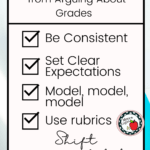Plenty of well-respected educators have developed logical, erudite arguments about why grades are bad. If you’re interested in reading about the dangers of grading, here are several articles from well-known writers. Each makes a good argument. I don’t disagree with any of them.
- “Teachers Going Gradeless” by Arthur Chiaravalli on Medium
- “Is It Time to Reexamine Grading?” by Amanda Parrish Morgan at JSTOR
- “Could You Teach Without Grades?” by Jennifer Gonzalez at Cult of Pedagogy
- “Are Grades Reliable? Lessons from a Century of Research” by Susan M. Brookhart and Thomas R. Guskey at ASCD
- “How I’m Changing Grading in My Middle School English Classroom” by Stephanie Hampton at Writing Mindset
However, I don’t teach in a district where I get to make decisions about how to weight my gradebook or about whether or not I have to keep traditional grades. The gradebook set up is largely determined at the district level. Additionally, my community puts a certain emphasis on grades. While my colleagues and I may emphasize the importance of growth over grades, parents and students are often very invested in grades (as a student, I was every bit the Hermione in the room).
Basically, that means this isn’t an article evaluating the efficacy of grades. This post focuses on how to eliminate arguments about grades, say from a student or parent challenge.
I don’t often have parents or students argue grades with me. Sure, I get some questions. When this does happen, it’s good for me to breathe and take heart in the fact a student is interested in their grade. Similarly, I also remind myself that such questions aren’t personal. But, on the whole, I don’t spend much time having to defend my gradebook. And today I want to share how I avoid frequent arguments about grades.
This post this post may contain affiliate links. Please read the Terms of Use.
Have a Consistent Plan
In the secondary classroom, the syllabus outlines everything for parents from day one. This document communicates to students and parents that you are ready for the first day of school and shares your vision for the class.
Include your grading plan in your syllabus, and ask students and parents to sign the syllabus to signal their understanding. A signed syllabus can be a good reference point for later in the semester. Consider including these details so you’re communicating upfront:
- Grading categories and weights
- Late work, absent work, make-up, and retake policies
- When you will update grades (weekly, bi-weekly, on Tuesdays, etc.)
- How parents can access your school’s gradebook system or learning management system (we use Google Classroom)
- What resources are available for students struggling with their grades (tutoring, the writing lab, study groups, intervention, etc.)
The syllabus doesn’t have to be a boring document either! You can check out my best-selling syllabus scavenger hunt or BINGO game.
Communicate Everything
Each time you introduce a new assignment, especially something worth significant points or that isn’t in a familiar form, make sure communication is a priority. Over-communicating early prevents confusion and frustration later on. Here are some ways to make sure you have fully communicated assignment details and expectations with students:
Firstly, set clear expectations.
- Establishing expectations begins with lesson planning. Don’t unveil an assignment to students if you’re not sure what you’re looking for. Focus in on the skill, concept, or standard you want students to achieve. And then decide how you want students to demonstrate their understanding. Once you can answer these questions, you can begin formulating your expectations for students.
- Once you’re ready to share expectations with students, be specific with the what and how. What do you want from students? And how will they produce it?
- Post expectations in several places: on the assignment sheet, in the gradebook, and in your LMS.
Secondly, model, model, model.
After sharing expectations and a rubric, model your expectations for students. Show them exactly what you’re looking for. Better yet, accompany the modeling with a Think Aloud so students can hear you processing. In a virtual classroom, you can even use some of my favorite tech tools to capture modeling.
Also, rubrics save lives (and grades).
A rubric is a great way to establish clear expectations and hold yourself and students accountable for meeting those goals. Rubrics will save you time in grading and help keep everything equitable. I use rubrics for everything from seemingly simple tasks like writing a friendly letter to more complex tasks like producing a well-developed, evidence-based paragraph.
Finally, evaluate exemplars and give them grades.
For students, a rubric is an abstract beast. However, once students see a rubric in action, it becomes a tool that they can use to measure their progress. Save exemplars from previous students, strip them of identifying information, and use the rubrics together. Do this for even the simplest tasks so students become used to the process. Earlier this year, my students were writing emails to practice tone and to practice communicating with me in case (when) we switch to distance learning.
Even for such a seemingly simple task, I gave them a rubric (which you can find for free here) and provided them with example emails. In this situation, I wrote the emails from the perspectives of characters in our class novel, but the process was still the same.
Shift the Responsibility for Grades
Ultimately, the goal is to shift responsibility to students. Each step in this process–signing the syllabus, sharing expectations, modeling, using rubrics, and evaluating exemplars–is designed to shift responsibility to students.
When students are accountable for their learning, they have the opportunity to take ownership. That’s the beauty of expectations: they make students responsible for their own success.
With all of this in mind, the best way to show students that they are in charge of their grades if to offer a generous retake and revision policy. Except in extraordinary circumstances, I don’t allow full-blown test retakes. There doesn’t seem to be much value in simply retaking the same test.
However, there is value in revising test answers and engaging in metacognition. That’s where this free tool comes in! I use this freebie with students to help them revise tests.
With writing, further revision requires engaging with my comments in Google Docs.
Here are the details of my retake/revision policy:
- Formatives may be revised up until the day of the summative because formative growth informs summative success.
- In order to revise the summative, all the formatives must be submitted even if they are late. Frankly, there’s little point in the summative if a student hasn’t received formative feedback. In the context of writing a paper, this encourages students to submit rough drafts.
- Because units of study build on one another, any summative revisions have to be complete within 10 school days of my returning a summative grade.
- Summative revisions usually require a re-teaching session, trip to academic lab, before/after school or virtual tutoring session, or some other opportunity to focus in on the concepts and skills with which a student struggled. Without this, students mostly get frustrated.
- Because of gradebook deadlines, the midterm and final cannot be revised. Honestly, if the deadline weren’t there, I’d be glad for students to revise.
At the end of the day, grading is nearly every teachers least favorite part of teaching. Like so much in education, grading is a necessary chore. With these tips, though, you can limit the number of ways parents and students challenge your gradebook and encourage students to take ownership of their learning!
Sale News
Speaking of grading, this week Teachers Pay Teachers is throwing a Bonus Sale today, 15 September 2020. Use this sale to pick up rubrics, activities, and lessons that will limit your grading and save your change! All of your Moore English favorites will up be to 25% off when you use the code EXTRABONUS at checkout. Use this sale to pick up my newest and most-popular Moore English resources:
- 3 Tools to Teach “If-” by Rudyard Kipling
- “[i carry your heart with me (i carry it in]” Analysis Pack
- “’Hope’ is the thing with feathers -” Poetry Analysis Pack
- “Before a Painting” by James Weldon Johnson Analysis Pack
- “Social Distancing” by Juan Felipe Herrera Poem Analysis Pack
- 4 Tools for Teaching “The Danger of a Single Story” by Chimamanda Ngozi Adichie












